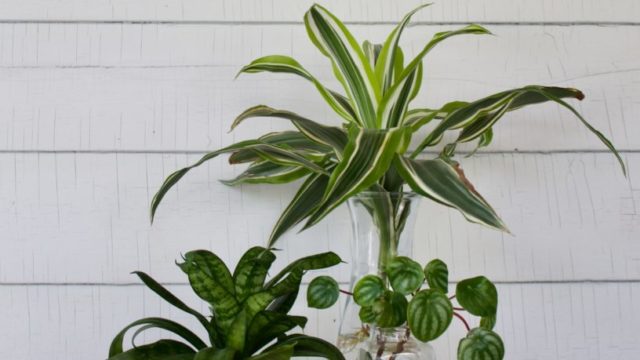
After getting over the crippling fear of cutting and pruning your plants, you can prepare for propagation. And, let me tell you, propagation is really fun. There is something incredibly satisfying about watching a baby plant grow up to be a mature, strong plant. Too bad there isn’t an experience that like with humans.
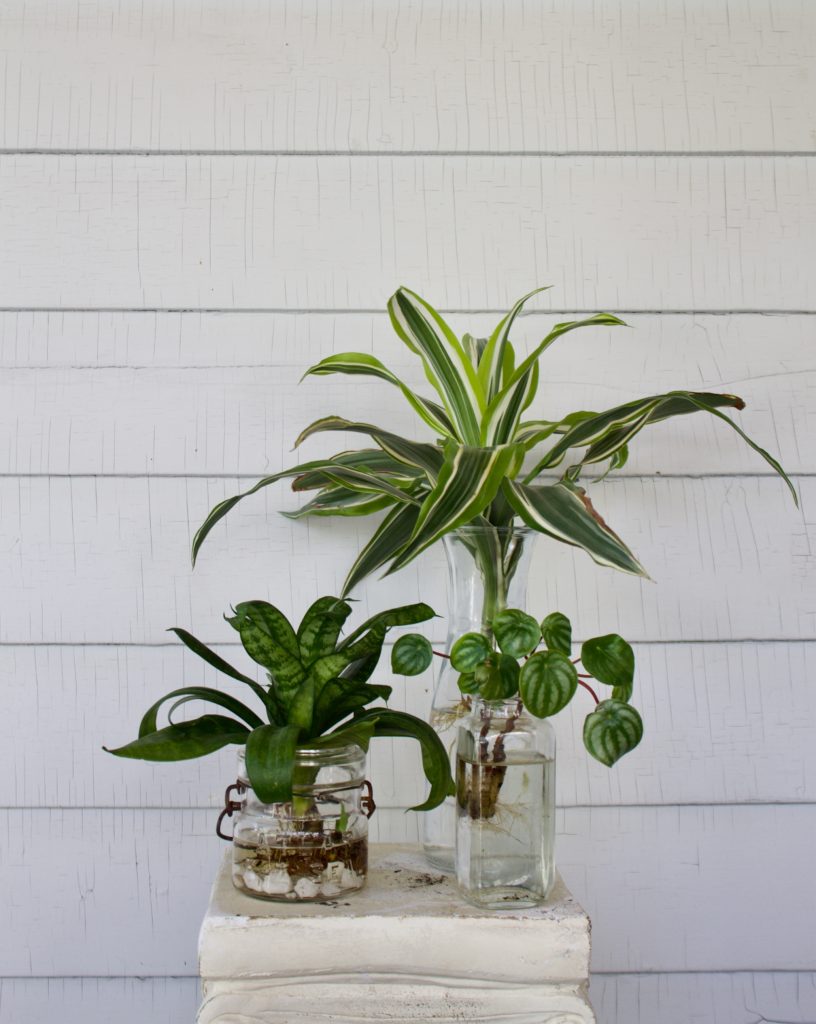
The internet is riddled with ways to propagate plants, but an easy way is rooting cuttings in water. The rooting plants in water method is pretty foolproof, and all you need is a glass jar (which many people have) and water (which people should have) so propagating this way is basically free. And you get to watch those little roots develop! It’s a fun time. Plus, I love feeling like a mad botanical scientist with glass jars everywhere. Weird, but true.
When to Propagate Plants
When is the right time to propagate your plants? There really isn’t a clear answer as the maturity and heath level of said plant plays a big part in the decision. Since when to propagate is tricky, it’s becomes a question of why you should propagate.
I usually want to do one of the following:
-Have the plant retain a certain shape for aesthetic reasons – such as shaping a Monstera
-Keep its growth under control – such as pruning Pothos to stay bushy and not stringy
-No reason, I just want to
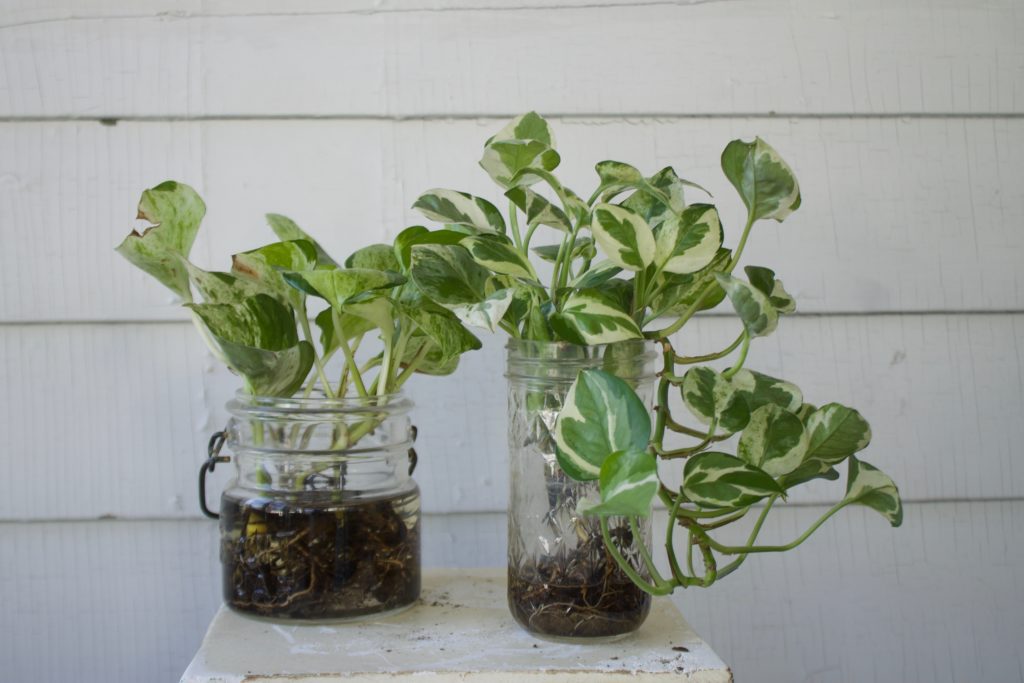
If a plant is growing too prolifically, it should be pruned, and if it’s a healthy plant, that’s a good sign you can propagate it.
Here’s an example with Monsteras: I’m asked often if you can attempt to propagate a young monstera with one stem and a handful of leaves like this:
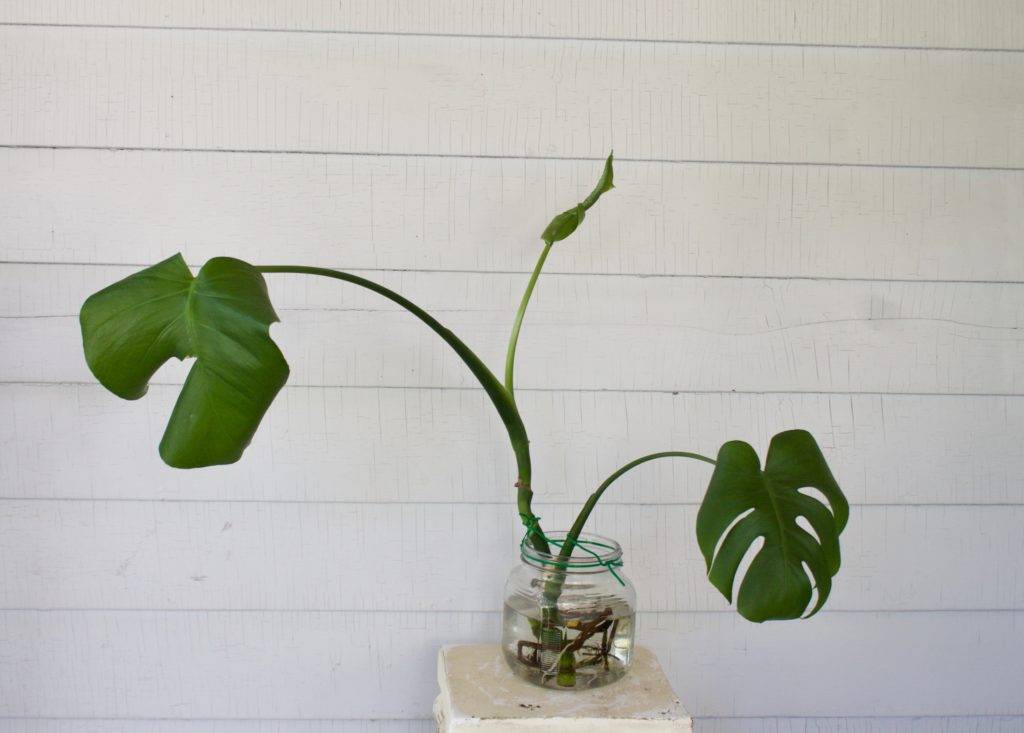
I often say no. Why? This is much too young. You would basically be chopping off the only growth the plant has which can be fatal as it is still immature in its toddler years. Even if there is a node like this, you should still give the plant time to grow.
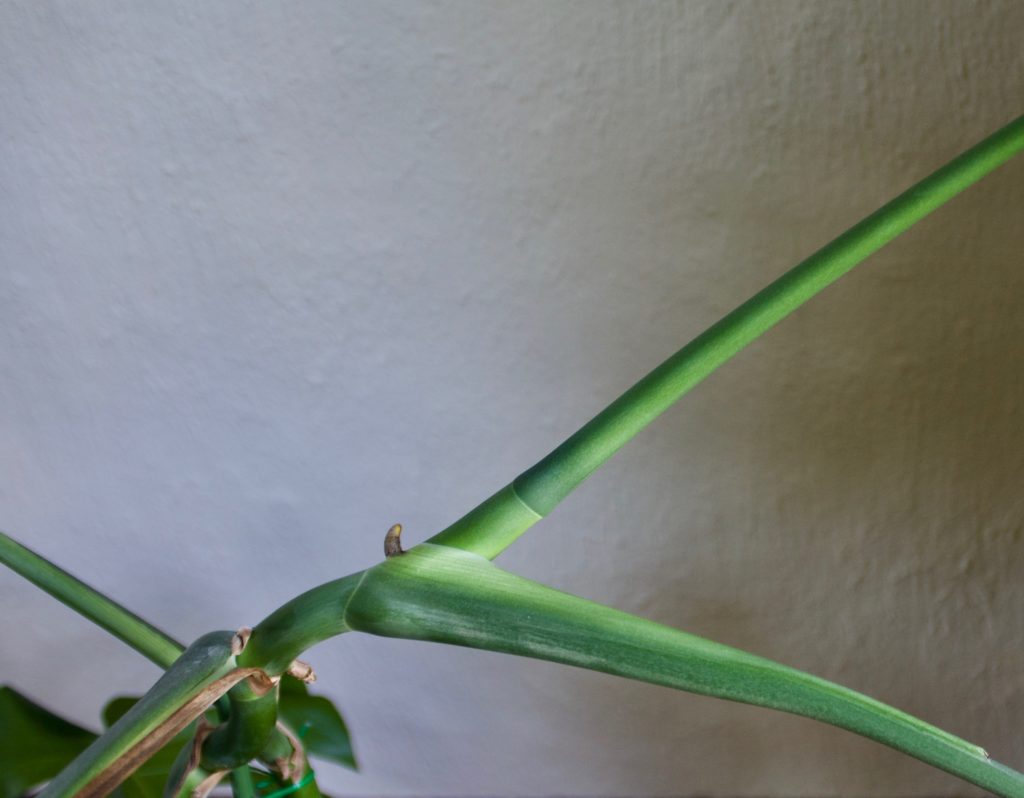
Don’t get desperate. You want to be mindful and choose a larger (preferably mature) plan with multiple leaves and stems. This allows the best chance for healthy root growth (see below) and a successful propagation.
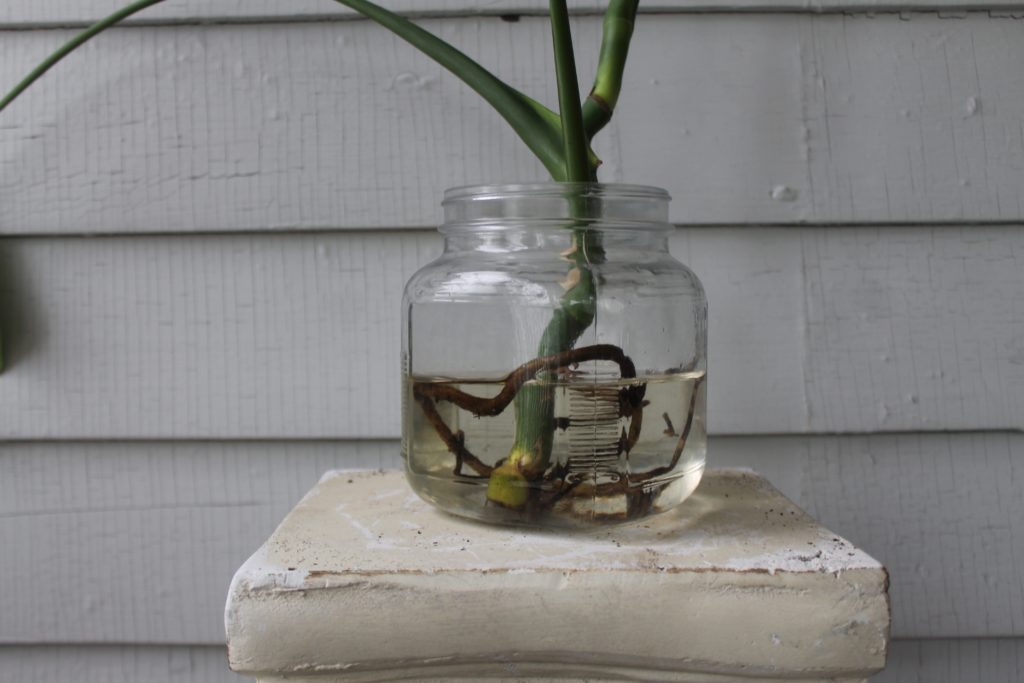
Now, like anything in gardening and in life, sometimes bad things happen. Yes, I’ve had some monstera root rot and a few Pothos dry out, but most of the time with proper care and precaution, propagation problems can be eliminated. 95% of the time my cuttings have grown up healthy and plump (in a good way).
How to Root Plants in Water
Tools for Propagation
Before you create a bunch of plant babies, prepare your tools. I suggest preparing a clean workspace and grabbing these items before you cut anything:
- A sterilized knife or snippy scissors
- The plant you are about to chop up
- A glass jar or vessel for said plant cutting
- Clean filtered water
- Optional: marble or aquatic rocks
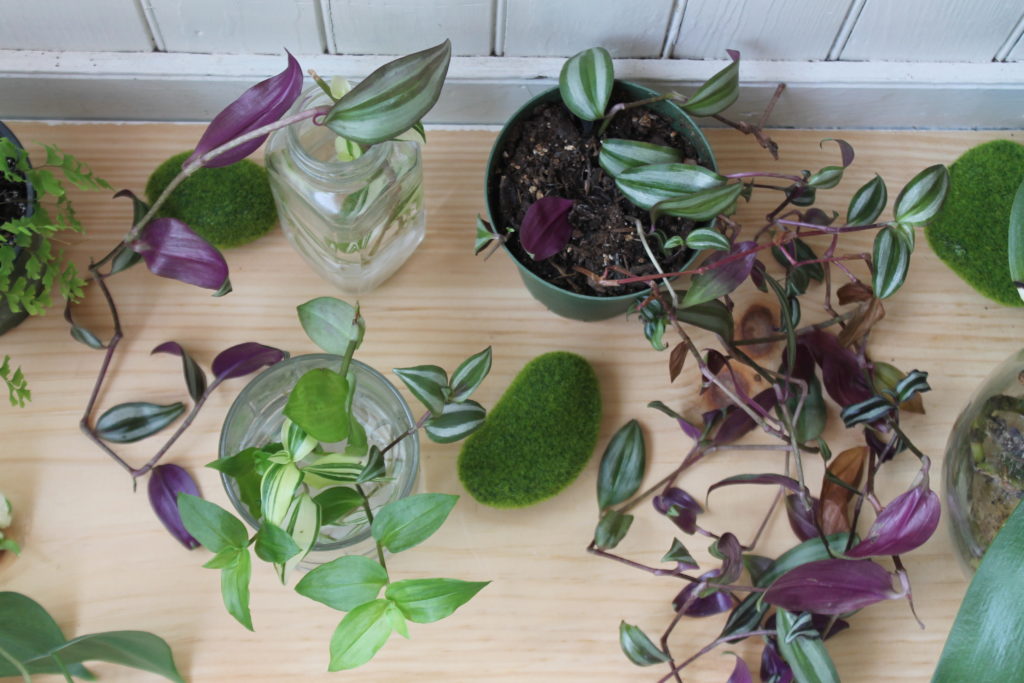
Easy Plants that Root in Water
While there are thousands of eligible plants you can root in water, here are a common bunch that are easy to start with:
-Aroids such as Monstera, Philodendron
-Pothos
-Tradescantia
-Begonia
-Christmas Cactus
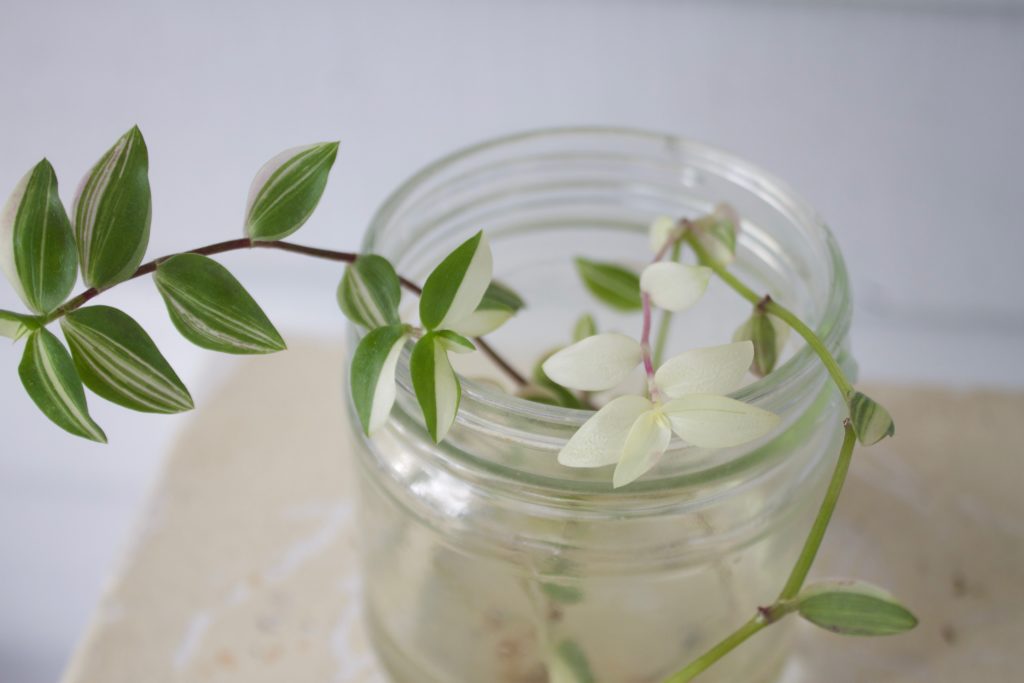
These plants are easily propagated by cutting a piece of them and placing it in water to root. The roots then take an average of 1-3 months to develop, depending on the plant.
How to Propagate Plants
Stem Propagation
These plants need to have a chunk cut from the mother plant and must include a node or root in order to propagate.
- Find a stem with a few leaves and a little node.
This node will turn into roots. Sometimes this node is not visible as a nub, but as a little root band (like on Tradescantia, or Peperomia, below). Cut right below this node.
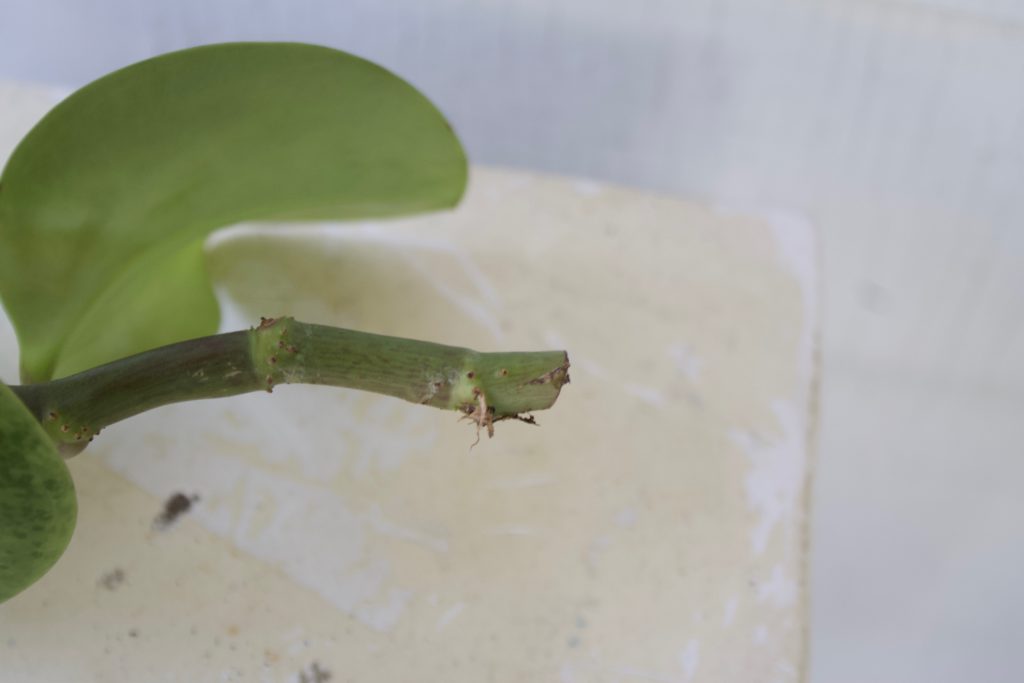
- Place the cutting in your jar.
Fill with filtered water so the node is fully submerged, usually about 1/2-3/4, but leaves are free and above water. I put some rocks in the bottom, too.
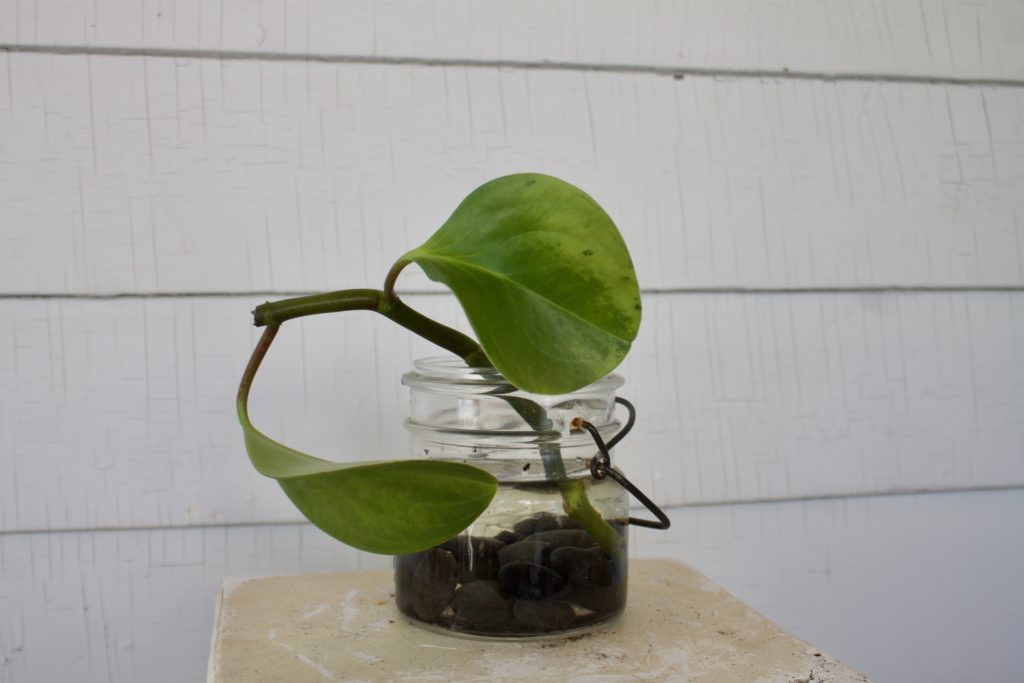
- Put in a warm, bright location.
Avoid direct sunlight. Change water every few weeks. The average time to start seeing root develop is a month or so.
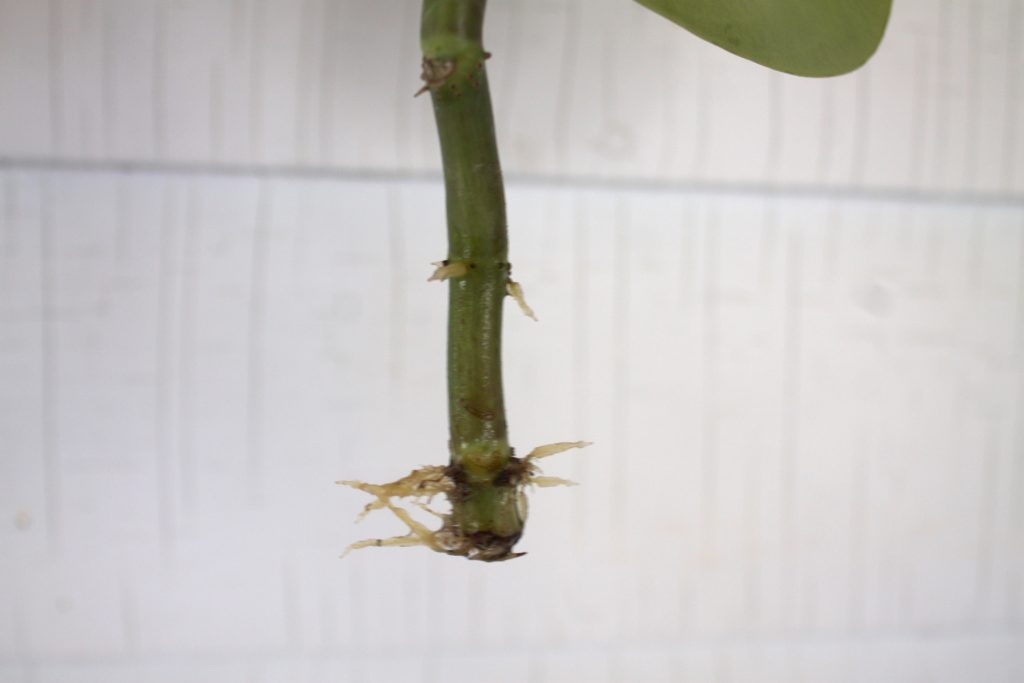
- Time to plant?
I like to keep my plants in water longer than they need to be, sometimes 6+ months, to make sure it has solid growth. Once there are solid roots, plant in high quality soil.
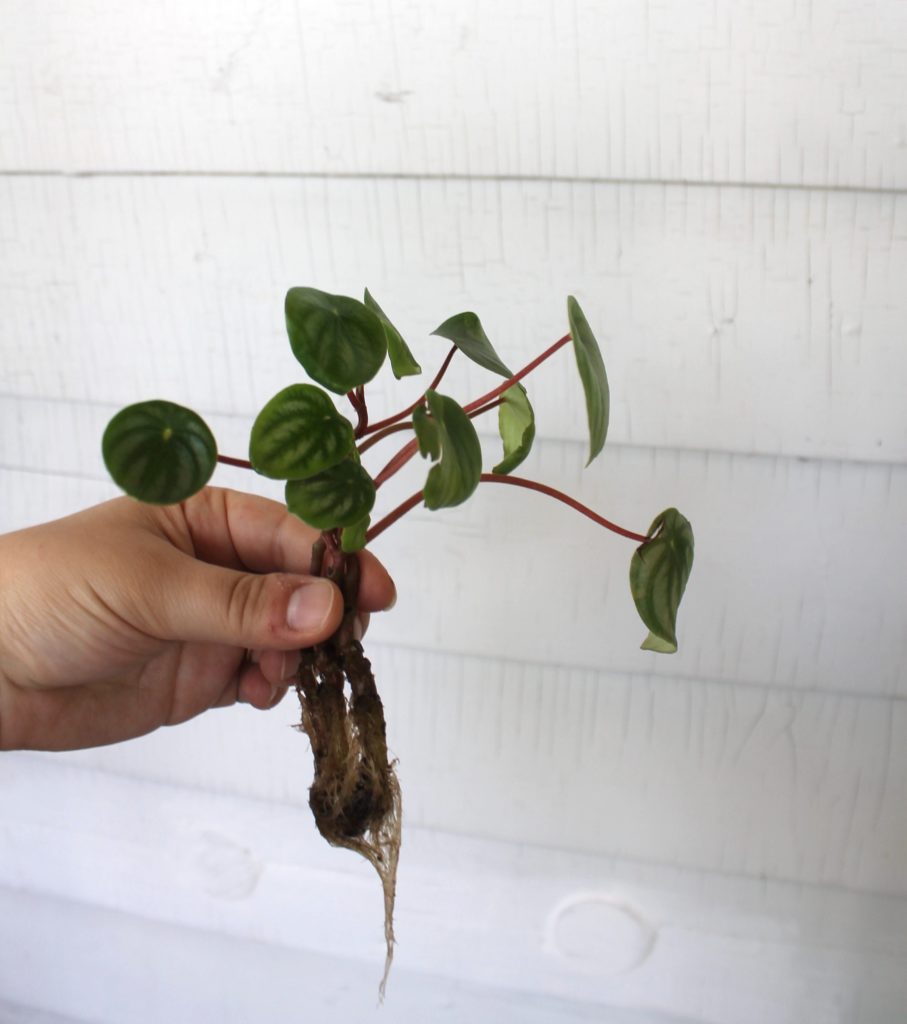
Plantlet Propagation
Some plants push out little baby plantlets that can be separated from the mother plant and placed in water to encourage root development. I like to think of it as giving them a leg-growing boost. These are the best plants to propagate this way: -Pilea peperomioides
-Spider Plants*
-Sansevieria
-Peperomia argyreia (pictured above)
*Note that Spider Plants produce their plantlets on the end of their leaves. It’s weird but true. You can separate these the same way, just cut them sharply off the mother plant and plop them into your jar. There’s no need to rinse the roots (which are usually visible) since they were not birthed in soil.
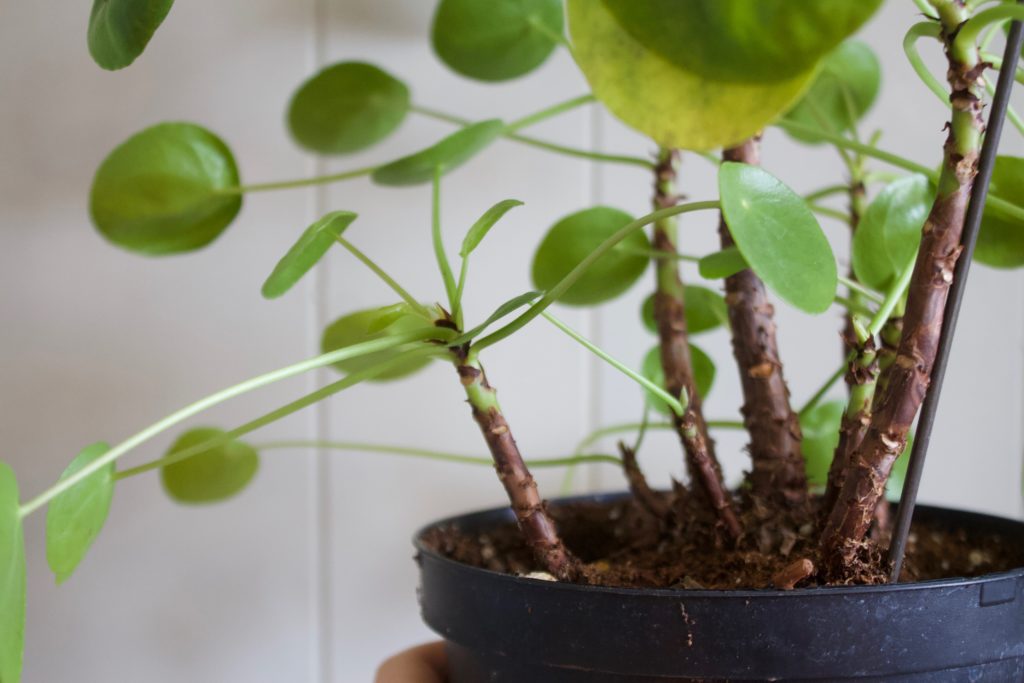
- Identify the plantlet is healthy and strong.
- With a sharp knife (scissors may not work) separate the plantlet from the mother plant cleanly.
- Clean the cutting’s roots thoroughly under lukewarm water (hot or cold water can be damaging) to remove any extra soil.
- Prepare your jar and center the plantlet so the base floats in water. It’s best not to have the bottom of the plant touch the bottom of the jar.
- Wait 3-5 months and you should see solid root growth! I recommend changing the water every week.
When planting time comes, be sure to use a high quailty soil (I like Espoma) mixed with a bit of perlite (about 1/4 ratio to soil) and some stones on the bottom for drainage. Place your new plant in a bright spot out of harsh sunlight and turn regularly to keep him straight.
This is my Pilea after 5 month in water and just after planing:

And then after 4 months in soil:
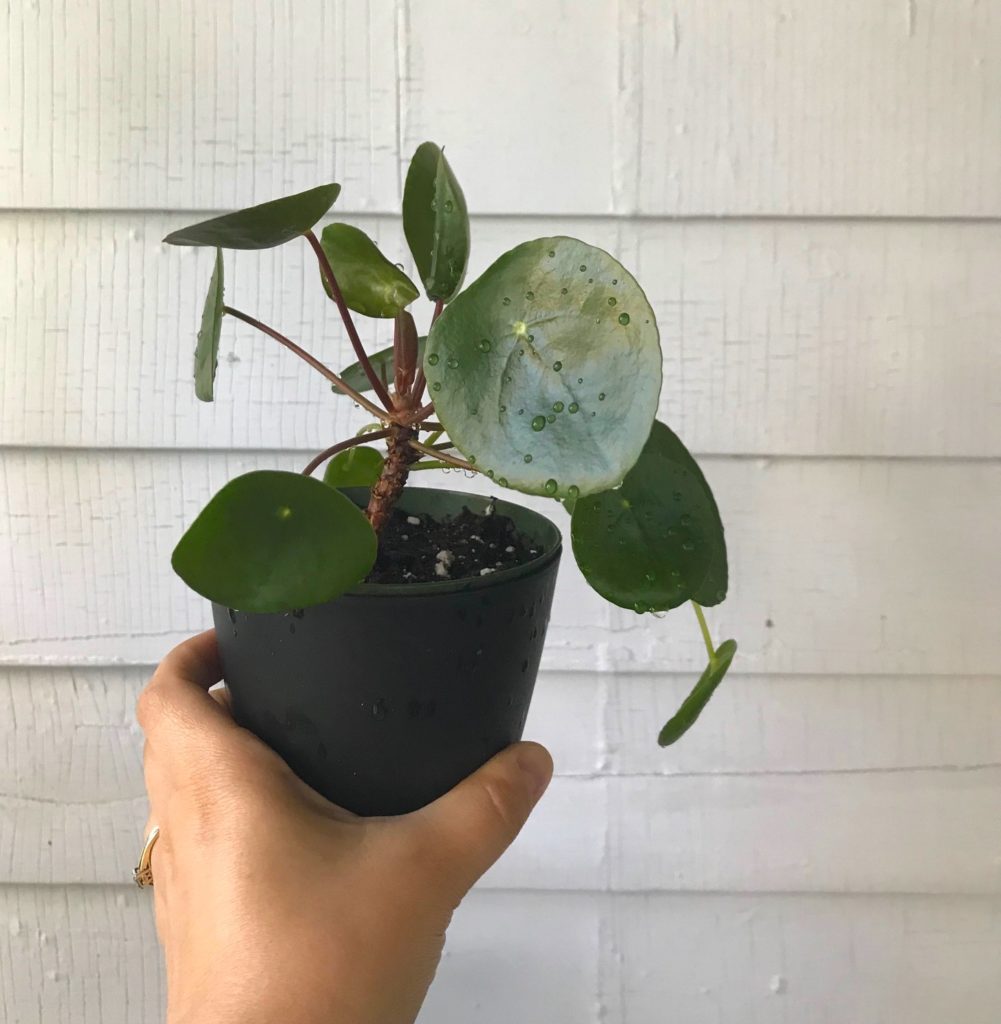
Isn’t he gorgeous?
Hopefully I’ve made a somewhat daunting task of propagation easier and tear-free. Take the plunge and make some more plants! Rooting plants in water is the most forgiving method out there.
Share you propagation stories or questions below! I’m happy to help.
*This post contains affiliate links so you buy great stuff that I like.

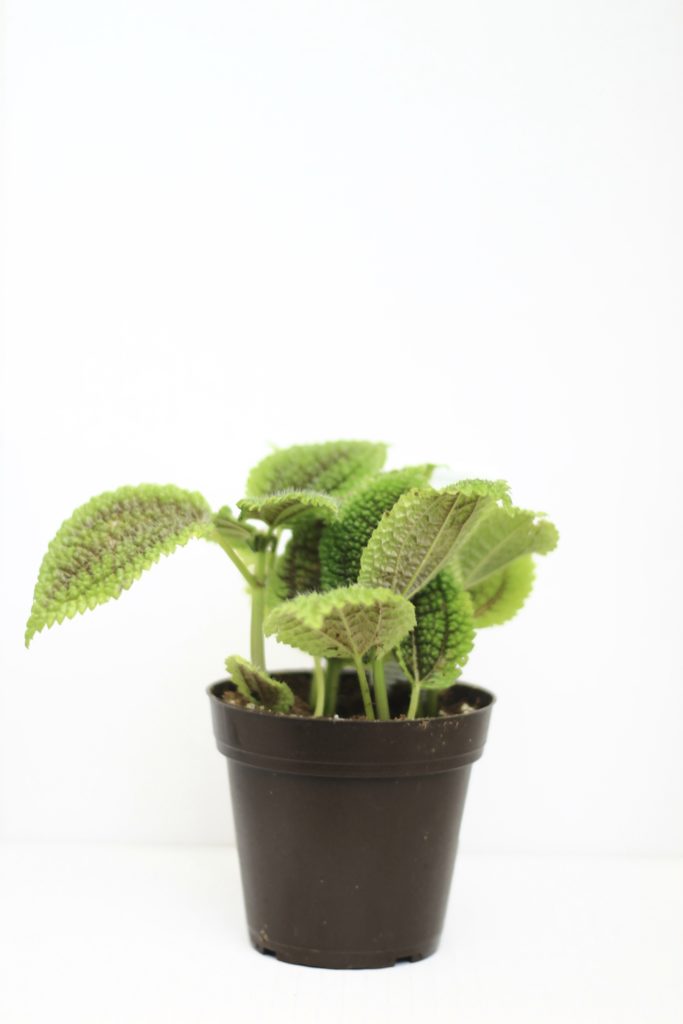

What is the tallest plant in your first photograph? I have one of these I can’t remember what it is. It’s recently tipped over and is sprouting a new plant from its roots. I’m not sure how to handle it.
Hi Brittany, it’s a type of dracaena. These guys are easy to propagate, so if you have a baby growing you from the mother plant should be able to cut is off and place in water. You may be able to save the mother plant too if it just fell over! 🙂
Hi! I’m new to plants in general but tried my hand in water propagating swedish ivy. I ordered cuttings online and they were doing great but I accidentally left my room door open and my housemates cat knocked them over. By the time I got home the roots turned from white to brown and look a little shriveled up. I’m not sure if I should remove the old roots somehow and place them in water again; for now I just put them back and am crossing my fingers that they’ll survive. Do you have any tips for my situation?
Oh no! But Swedish Ivy is pretty durable. The most important thing is to hydrate those roots. Make sure you use filtered water, keep them submerged and the water fresh (I’d change it every week or so). Also keep the cuttings in a bright and warm spot away from drafts and they should be just fine. Any roots that didn’t make it will turn mushy, so when you check on the cuttings just remove any that look unhealthy.
Great information. I have several rooted angel wing begonia to transfer from water to soil.
Congrats Ruth!
Can you propagate multiple cuttings in same jar? Should each cutting have its own?
Hey Marisa, I’ve tried this and I always have better luck with one single cutting per jar. I don’t know why, but I get better root development and leaves when a cutting has its own jar.
Good day! I bought a clipping of a monstera Adansonii and it was in moss. I transferred him to a mason jar with water. The spot where he was cut is brown. Is this ok? Do you think he’ll live? I placed him in an open zip lock for humidity, I’m in North inland San Diego. Kinda dry area. Thank you!
Hi! Some browning is normal but what you don’t want is anything squishy or smelling bad – that indicates root rot. If the end is firm but brown you should be fine but if it’s squishy you may have to trim the end off and start over. Also as far as a plastic bag, that’s not needed if the plant is propagating in water.
Ok, thanks! He’s with my other plants also and seems to be fine. There is a node, I forgot to mention that. I just found you blog, it’s fantastic! Thank you!
Thanks for the great info! I just propagated a little baby. Could you tell me where you got the plant pot with the white stripe? It’s lovely!
Hi Courtney! It was $1 from Target last year, sometimes they have similar ones in the bargain section at the front of the store but they probably won’t have this one again. 🙁
I recently planted my Monstera Adansonii after a shout 2 months of propagation. How do i water it now? I’ve read that the transition from water to soil can be hard for plants and I’m scared to over or under water it
It can, so the trick is to keep the soil lightly moist at all times. I would get a moisture meter or just check every few days to see if the soil is dry. Also be sure to keep the plant in a partially sunny spot.
Is it safe to use fertilizer? If so what kind of fertilizer do I use?
Hi Jessica, You can, but I rarely fertilize any plants propagating in water, I find it really doesn’t help and can lead to fertilizer burn or the cutting melting away. When I do fertilize plants in soil I use Jacks only, which I link to in my shop here.
Hi there, great article!
I have a ficus that has been propagating in water for a long time, it has a great root system going. I’d love to transfer it from the glass jar it’s in now to a ceramic vase, is that possible, or do the roots still need some sunlight if they’re in water. I guess my question is, is glass essential or will any type of vessel be ok once established?
Thanks!
Hi Bek! A transparent or translucent vessel is key when during propagation but a opaque one is totally fine once if teh cutting is in soil. Sunlight does need to be able to come through if the plant is in just water or the root will just rot. I hope that answers your question!
The healthy leaf of my Alocasia Amazonica broke off. If i place this in water, will it continue to grow and even root?
Hi Jenni, It will not, it needs some kind of node or root piece to re-root. But it will look pretty and last a while in water!
Hello! Kind of unrelated but I am trying to grow mango from seed. Is there an advantage to propagating in water first and then transferring to soil later? Or if you are going to transfer to soil eventually is it better to have it in soil from the start?
Hi Max, I would follow a similar system to sprouting an avocado seed personally (so, in water), but you can also try the soil method. Honestly if you have multiple seeds I would try a few different options since they don’t always sprout. I hope that helps!
Hey there! I have recently kept a spider plant to propagate in water which I accidentally pulled apart from it’s mother root!
Although it has developed some tiny roots but the old and new leaves have started becoming blackish and squishy as you stated above. They are falling off! What shall I do now?
Hi Ankita! If the roots are healthy, white and plump, you can just remove these icky leaves, but if the roots are starting to turn black the cutting will probably not survive. You can keep it in water to see what happens, but usually anything turning black is a bad sign.
Yes, the roots are fine.
I am doing the same way you’ve told me let’s see what happens…
Thanks so much for the advice!
Hi,
A word of caution; the plant in the tall vase at the top of the first two images on this page is in the dracaena family, which is highly toxic to cats, dogs, and horses (see the ASPCA page). While it’s not a plant featured individually on this page, it is possible someone will see it in that image and assume it’s a safe plant for pets.
Hi, grea article! I’ve put a large pilea cutting in a jar filled with water. The roots were growing great and were white at first, but the last two weeks or so, they started turning brown.
Some leaves have also started curling up and getting wrinkly. There are, however, little shoots of miniscule pileas growing from the side of the stem. I use tap water, which does contain quite a lot of calcium in our area.
Should I be worried, or do you have any advice on how to remedy this?
Thank you so much!
Can camellias be rooted in water? Any different instructions for them?
Hi John, not quite – camellias and shrubs are better propagated by stem cuttings. So taking a piece of healthy stem, dabbing the tip with root hormone and then putting in equal parts perlite and potting mix and place in a very warm and humid location. I always put in some kind of clear container so I can see root growth. Good luck!
My Lily has leaves going limp and brown…I don’t know why? Should I pull it out of the soil and place it in a jar of water? Or will that cause root damage?
I would cut off any brown bits and move to water – lilies can be tricky but that should work!